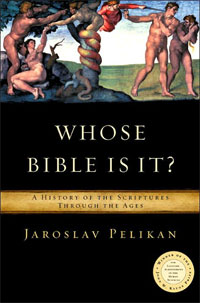Book Notes
 Jaroslav Pelikan, Whose Bible Is It? A History of the Scriptures Through the Ages (New York: Viking, 2005), 274pp.
Jaroslav Pelikan, Whose Bible Is It? A History of the Scriptures Through the Ages (New York: Viking, 2005), 274pp.
Reading any book by Jaroslav Pelikan is a rare privilege and pleasure, not to mention an occasion for envy and humility by lesser mortals who fancy themselves as scholars. Magisterial, meticulous, encyclopedic, prolific, and prodigious, Pelikan is the Sterling Professor Emeritus of History at Yale University where he served on the faculty from 1962–96, the past president of the American Academy of Arts and Sciences, and in 2004 the recipient of the Library of Congress's annual John W. Kluge Prize in the Human Sciences (the $1 million award focuses on academic disciplines not covered by the Nobel prizes). Most in his guild would consider him the greatest historian of Christian thought in his generation.
Now in his early eighties, Pelikan has written a wonderfully accessible book about the nature and role of the Bible in its worshipping communities that follows as a sequel to his Jesus Through the Centuries (1985) and Mary Through the Centuries (1996). The Biblical documents are decidedly historical documents, not gold tablets dropped from heaven and kept "pure" from human time and place. The thirty-nine books of the Hebrew Scriptures, for example, were written across about 1,000 years. The twenty-seven books of the Christian New Testament, he observes, are hardly a single book but rather a sort of mini-library of early believers. As documents embedded in human history, Pelikan reviews how these Scriptures were first written, then transmitted, formed into a single rule or canon in a way that excluded other noteworthy candidates, translated into other languages, hand-copied and then commercially-printed, and variously and often divergently interpreted. Along the way he demonstrates how the Scriptures impacted and were impacted by art, architecture, hymnody, classical music, liturgy, economics and politics.
However historical, though, believing readers rightly approach the Scriptures as more than ancient artifacts that require, even deserve, scholarly scrutiny, for in them we encounter the God who speaks and acts. Pelikan clearly loves "the Good Book" that he has studied so assiduously for sixty-plus years (both his grandfather and father were Lutheran pastors), and he always has one eye on the ordinary believer in the local church or synagogue. In their personal piety and corporate worship believers encounter "the power of the Bible to change lives" (p. 133). We can and must analyze and scrutinize the text with all the tools of the historical sciences, but ultimately, Pelikan reminds us, "I am not the subject but the object in my encounter with the word of the Bible...The historical or philological desire to comprehend what it says has been and is vastly less important than the religious need to understand it in order to obey it" (pp. 249–250). This is because "to the eyes and heart of faith," the Bible is, "after all, a love letter, one long love letter." Pelikan's ultimate intention, then, in this book about the Book, is "not to undermine its authority but to celebrate its message" (pp. 201, 231).


